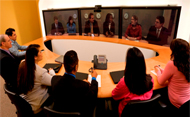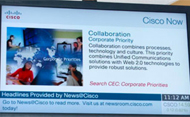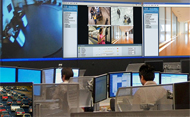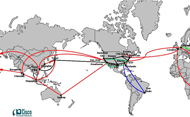IT provides the medianet and tools that employees use to communicate, collaborate, educate, and protect people and assets.
Communication and collaboration have always been central to the Cisco business strategy, but the tools used have changed over time.
Early in the company's history, network-based collaboration generally meant sharing information by phone, voicemail, or email. Next, Cisco began using the network as the platform for advanced voice collaboration tools, such as unified messaging, presence, and extension mobility. Still later, Cisco IT added secure remote access and mobility services, so that employees could use corporate collaboration tools from home, hotel, or customer offices.
More recently, business video has become a signature part of Cisco's corporate culture. The company started using business video tools in the late 1990s, including:
- IP video surveillance to protect people and assets
- IPTV for one-way communications between management and a global workforce
- Video on demand (VoD) for training
Cisco gradually added office videoconferencing. At the outset, adoption was slowed by the difficulty of setting up the connection, high support requirements, and a limited number of endpoints. Usage increased when Cisco employees could use Cisco Unified Video Advantage to add video to regular IP telephony calls. But before Cisco employees could fully embrace business video, the company culture had to change. "Management and employees didn't have a clear understanding of the differential business value compared to voice-only calls," says Suresha Bhat, senior IT manager, Cisco.
The introduction of Cisco TelePresence in 2006 propelled business video to the forefront of Cisco's collaboration strategy. The initial goal was travel reduction, and indeed, Cisco TelePresence reduced travel by 11 percent in 2007 and 15 percent in 2008, exceeding the 5 percent travel-reduction goal. But the company quickly recognized that business video had larger implications for business competitiveness. In particular, the use of business video enabled more frequent collaboration, which accelerates decision making, increases customer intimacy, and encourages innovation.
Employees enthusiastically adopted Cisco TelePresence. Cisco IT collected data about travel cost savings, which encouraged Cisco business units to deploy more units globally. When Cisco announced the Cisco TelePresence System 500, designed for individual use in an office or home, Cisco IT received 200 requests almost immediately, from executives and subject-matter experts who meet with customers.
Suresha Bhat
Senior IT Manager, Cisco
Cisco TelePresence became the catalyst for much more widespread adoption of other business video tools at Cisco. After enjoying the "in-person" Cisco TelePresence experience for an initial meeting, employees became accustomed to seeing each other, and began using Cisco WebEx and videophones for subsequent meetings. Today (March 2010) business video is pervasive at Cisco:
- Over 700 Cisco TelePresence systems have been deployed worldwide.
- More than 50 IPTV sessions a month keep tens of thousands of employees up to date on Cisco news.
- Employees download more than 85,000 videos on demand each month, many of them for training.
- More than 4000 video surveillance cameras help to keep Cisco employees and buildings safe.
- Employees can meet in more than 1200 videoconference rooms.
- More than 30,000 employees use web cameras to add video to their voice conversations.
Factors that contributed to this burgeoning adoption of business video applications at Cisco include:
- Ability to combine different types of business video, for new benefits: Cisco takes advantage of the interoperability of its business video tools to give employees choices in how they work. For example, employees can view live video of executives captured in one Cisco TelePresence room in other Cisco TelePresence rooms, or on digital signs in common areas, on video portals, over IPTV, and even on their smartphones. To deliver the video in the right resolution and format for the variety of endpoints, Cisco uses the Cisco Media Experience Engine (MXE).
- Global workforce: Today's work teams tend to be distributed globally. Team members need a way to collaborate in real time, without delays, lost productivity, and costs of travel. Video overcomes distance barriers.
- Faster pace of innovation: "Cisco is working to change the way we live, work, play, and learn," says Sheila Jordan, vice president of IT for communication and collaboration, Cisco. "To do that, everyone at Cisco needs to be very creative, in what we do and how we do it. Business video enables us to take advantage of all the expertise both within and outside Cisco, from employees, business partners, vendors, and customers."
- Commitment to environmental sustainability: Cisco actively looks for ways to reduce its carbon footprint, and travel reduction is a large part of the strategy. Cisco Chairman John Chambers announced in May 2009 that Cisco had permanently cut its travel budget from US$750 million to $350 million run rate annually, due largely to the company's increased use of business video.
- Employee and customer expectations for video: Many Cisco employees and customers have grown up with video and are comfortable producing and consuming it. A product manager, for example, might prefer to produce a 3-minute video to explain a new product feature rather than write a memo about it. And many employees and customers would rather view a video than read a data sheet.
Cisco overcame a two-part challenge to getting the most from business video. The business challenge was clearlyunderstanding the value of the different types of business video to communicate, collaborate, educate, and protect people and assets. The IT challenge was building a network that could support growing video volume.
Cisco has fostered a corporate culture that appreciates the use of business video tools for global collaboration. Cisco IT played two critical roles: introducing tools to create, distribute, search, and use video, and fine-tuning the company’s medianet to handle growing traffic volume.
Cisco IT uses a range of business video tools for benefits ranging from faster decision making and shorter sales cycles to enhanced customer intimacy and improved employee communications (see "Results"). For in-depth case studies on each of the following tools, visit: www.cisco.com/web/about/success-stories.
In the first two years that Cisco used Cisco TelePresence, 60 percent of all meetings involved demonstrating technology to customers. Management regarded executive decision making and travel reduction as the main benefits. “We selected locations for new rooms based on their potential for travel reduction,” Bhat says.
A change occurred after Cisco had deployed its first 200 Cisco TelePresence units, according to Bhat. "About 19 percent of Cisco TelePresence meetings still replaced travel," he says. "But we began to also appreciate the value of Cisco TelePresence for internal collaboration, to enable distributed teams to work together more effectively." For example, Cisco's financial teams in Research Triangle Park, North Carolina and London use Cisco TelePresence to meet regularly (Figure 1). Similarly, Bhat prefers to conduct team reviews with Cisco TelePresence instead of in-person because he saves almost a full day of travel time. Other factors leading to the need for more frequent collaboration at Cisco include distributed teams, the formation of business councils with members from throughout the Cisco global enterprise, travel-reduction initiatives, and more frequent product introductions. "Economic, social, and cultural changes impelled us to use Cisco TelePresence in new ways," says Bhat.
The average utilization of Cisco TelePresence meeting rooms is about 50 percent, based on a 10-hour business day. In general, rooms with multiple screens are more popular than rooms with one screen. In China, employees come to the office to join Cisco TelePresence meetings outside of normal business hours, so that they can meet face-to-face with colleagues in other time zones. Therefore, utilization of the systems in the company's China offices is 150 to 200 percent, based on a 10-hour business day.
After recognizing that Cisco TelePresence provides at least as much value for collaboration and customer intimacy as for travel reduction, Cisco changed its criteria for where to build new Cisco TelePresence rooms. The Cisco TelePresence room in Bentonville, Arkansas, for example, is used an average of only once a month. But Cisco easily justified the cost because the chairman of Wal-Mart, a major Cisco customer, visits the room to meet with Cisco executives.
Intercompany Cisco TelePresence connects Cisco's 50 largest customers to its enterprise network, enabling Cisco users and customers to meet face-to-face without traveling to each other’s offices. Cisco conducted 6000 hours of scheduled intercompany Cisco TelePresence sessions in the first year, and that figure does not include spontaneous meetings. Now that the world’s top global service providers offer intercompany services, Cisco IT anticipates that the volume of intercompany Cisco TelePresence meetings will increase significantly (see "Next Steps").
Cisco employees can also use Cisco TelePresence to record high-definition video, which saves employees from having to rent time in a professional recording studio. They simply press a button on an IP phone in the Cisco TelePresence room to start and stop recording, and to automatically publish the video on Cisco Show and Share, the company’s internal social video-sharing portal.
Increased use of Cisco TelePresence for internal collaboration led to increased use of Cisco WebEx and standard-definition (SD) video conferencing. Cisco subject-matter experts often meet with customers the first time with Cisco TelePresence, for an in-person experience, and then use Cisco WebEx for subsequent meetings. "We have a new culture of wanting to see people when we talk to them," says Bhat.
Cisco employees and customers who are not near a Cisco TelePresence room can join the meeting using video conferencing systems. Cisco WebEx users can join the voice portion, and by the end of 2010 will be able to join the video portion, as well.
Cisco uses video on demand (VoD) to share ideas and information at low cost with large groups of people, at any time. VoD is typically used to train Cisco employees on new products and services, collect customer feedback, and share case studies. Cisco employees appreciate the flexibility that VoD gives them to fit classes into their own schedule. Senior managers like being able to disseminate a message consistently across a global organization. For example, when Cisco introduced a new compensation program in 2009, the executive vice president explained it on video that employees watched live or on-demand on their PCs and laptops. “Nearly everyone had watched the video within eight hours, and there was no confusion, as there might have been with an email,” says Bhat.
In 2008, in response to employee requests, Cisco IT launched an internal video-sharing portal called C-Vision, where employees could jointly develop, edit, publish, and search for short videos, usually 2 to 10 minutes, on new products and other topics. C-Vision was the predecessor to Cisco Show and Share, a product within the Cisco Digital Media Suite that Cisco began using in November 2009 (Figure 2).
"My team uses Show and Share to explain what we're working on to teams in other countries," Bhat says. "It's much faster to use a webcam or Cisco Flip Video Camcorder to capture a video than it is to write a long email and embed pictures. We use the built-in tools to edit the video, post it, and then simply email the link."
The number of people that access the video-sharing portal increased 300 percent in one year, from 27,000 in December 2008 to 96,000 in November 2009. "Adoption has been viral," says JoAnn Wilson, Cisco marketing program manager. "Our Show and Share portal started as a proof of concept and quickly grew to 6000 users, who are uploading hundreds of video monthly." As of October 1, 2009, Cisco users had uploaded more than 18,000 videos and 6000 photos.
Cisco IT is conducting a pilot to allow employees to record a video in a Cisco TelePresence room and publish it with one click on a Cisco Unified IP Phone, and plans to deploy this capability in production soon This capability will significantly increase video storage requirements. Therefore, Cisco IT plans to add an end-of-life date to videos, both to minimize storage requirements and deliver more relevant video when employees search.
Cisco regards network-based digital signage as a valuable medium to reach employees. Where the Cisco intranet provides in-depth articles, digital signs provide short, eye-catching messages with global, regional, or site-specific news (Figure 3). The digital signs appear in employee areas, such as cafeterias, fitness centers, and elevator waiting areas. To help ensure that content on the signs is fresh, relevant, and compliant with branding guidelines, Cisco IT collaborated with Cisco Employee Communications to develop the Cisco Now program, which includes infrastructure as well as a content strategy. Cisco IT can support all digital signs in the global enterprise with only two full-time employees.
Recently, Cisco has begun using the Cisco Digital Media Suite to stream relevant video to Cisco TelePresence displays for a few minutes before and after customer meetings. Content includes product advertisements as well as the customer's own ads, to demonstrate how the customer might use Cisco Digital Media Suite in its own Cisco TelePresence rooms when meeting with customers.
Cisco uses Cisco Video Surveillance Manager to protect people and assets throughout the global enterprise (Figure 4). Approximately 4000 video surveillance cameras are deployed in 580 sites in 72 countries. The bandwidth impact on the medianet is nominal, because video is retrieved over WAN only during rare security incidents.
Cisco takes advantage of the video surveillance infrastructure for more than physical safety and security. For example, employees can use a secure web interface to reassure themselves that their children are playing happily in Cisco daycare centers, improving job satisfaction.
Cisco is using the same investment to enhance the visitor experience. In 2009, Cisco embarked on a pilot to use the video surveillance cameras along with Cisco TelePresence to promptly greet guests in lobbies not staffed with a lobby ambassador. In the pilot, the moment a guest walks into a lobby, a motion detector on the Cisco Video Surveillance Camera sends an alert to an agent in the concierge room, who greets the visitor "in person" from a Cisco TelePresence display mounted beneath the camera. The visitor does not have to do anything, even lift a phone.
Cisco IT is considering a new program to allow visitors in one building to talk with Cisco personnel in other buildings, using the Cisco TelePresence system in the lobby.
"Only real-time interactive video, such as Cisco TelePresence and video conferencing, needs network QoS [Quality of Service] to help ensure a high-quality user experience," says Keith Brumbaugh, network domain architect, Cisco. In contrast, the business video tools used to view non-real-time and non-interactive video, such as video-on-demand, IPTV, Show and Share, and digital signage, use buffering to help ensure smooth picture quality.
Supporting high-bandwidth traffic from Cisco TelePresence, in particular, requires a combination of QoS and bandwidth, according to Niisa Carter, IT architect, Cisco. "The best design in the world doesn't take the place of a big enough pipe," she says.
“We had already designed a medianet, so we didn’t need to re-architect the Cisco WAN when we deployed high-demand applications such as Cisco TelePresence,” says Craig Huegen, Cisco IT director and chief network architect. The medianet that Cisco IT built is a peer-to-peer network that looks like a small version of a service provider’s network (Figure 5). In the United States, the network is based on SONET fiber backbone, with a ring path for backup, hub sites at several major Cisco locations, and dual access lines going from major hub sites on that ring to Cisco offices. In Europe and the Middle East, Cisco used service providers’ Multiprotocol Label Switching (MPLS) VPN services instead of SONET. “The peer-to-peer network gives everyone at Cisco a reasonably short path with low latency to everyone else,” says John Manville, VP of IT Networking and Data Center Services.
Cisco IT began targeted bandwidth upgrades in 2006, when it introduced Cisco TelePresence. "Bandwidth comes in fixed configurations, so each upgrade quadruples the amount of bandwidth," says Brumbaugh. "Each upgrade lasts for quite awhile, but eventually we'll need another round of upgrades."
Before making upgrades, however, Cisco IT first considers ways to optimize existing bandwidth:
- Using different codecs: Cisco currently uses the highest quality codec, 1080p. Cisco IT is considering using the 720p codec for employees using smaller screens or home Cisco TelePresence systems. The downside would be the possibility of changing the in-person experience.
- Changing the amount of bandwidth allocated to real-time, interactive video: Cisco IT currently allocates 30 to 50 percent of WAN bandwidth for Cisco TelePresence. The company is investigating the impact on other business video applications if the allocation is increased to 55 or 60 percent to accommodate the increase in multipoint global Cisco TelePresence meetings.
- Using Call Admission Control (CAC): To limit bandwidth increases, Cisco could implement a policy to only initiate real-time, interactive video sessions when there is sufficient bandwidth between endpoints. Intercluster CAC technology, currently under development, would provide this capability if Cisco chooses to use it. "Using CAC would enable us to oversubscribe bandwidth, perhaps by 1.5:1 instead 1:1, our current ratio," says Brumbaugh. "However, it would require careful thought to entitlement policies. Is a busy signal ever acceptable? If so, should sales calls always receive priority? Should scheduled sessions have priority over spontaneous sessions? Is it acceptable to reduce the resolution of ongoing calls from 1080p to 720p to accommodate more calls? Cisco management will need to make these decisions after considering the implications."
Cisco IT writes QoS policies to allocate 30 to 50 percent of network bandwidth to Cisco TelePresence and 10 percent to low-bandwidth video. The allocation for business video traffic is expected to grow as Cisco offers the option to record Cisco TelePresence sessions, and tightens the integration between Cisco TelePresence and Cisco WebEx.
"If you had asked me in 2006 if the Cisco network could support 700 Cisco TelePresence units, I’d have been skeptical," Brumbaugh says. "And yet we're doing it today with relative ease, because the underlying network is solid, and we've purchased sufficient bandwidth. We're confident that we'll find ways to scale even as we double the amount of Cisco TelePresence traffic."
Business video at Cisco has become an essential tool for internal collaboration, customer intimacy, technology innovation, and physical safety and security.
Business video makes it practical for Cisco employees to meet more frequently with customers to increase intimacy, with partners to respond more quickly to market opportunities, and with team members to accelerate decision making. Figure 6 shows the increase in Cisco TelePresence meetings from September 2008 to November 2009.
Cisco IT has created a Customer Advisory Board consisting of Cisco executive sponsors and nine customer chief information officers who share their experience and help influence solution development. All of the sponsors have Cisco TelePresence systems in their office, enabling them to meet more frequently with board members. "This has increased customer loyalty tremendously," says Bhat.
As an example, when a major financial institution was considering a US$200 million data center purchase, Cisco provided the customer with six Cisco TelePresence units for executives and IT personnel. The customer could consult with Cisco virtualization experts at any time, which helped the Cisco team to win the sale. Another customer that received Cisco TelePresence units decided to purchase more Cisco networking systems, reassured because help was always available. A leading global consulting firm was so impressed with the Cisco program that it has decided to provide Cisco TelePresence systems for its major customers.
From 2007 through 2009, the average sales cycle for all Cisco products decreased by 9.7 percent when account teams used Cisco TelePresence, according to Bhat. That decrease in sales cycles translates to 30 to 32 days for large data center sales. The main reason for the faster sales cycle is that salespeople can gather multiple subject-matter experts at the same time to answer outstanding issues delaying the sale.
As an example, in November 2008, Bhat and six other subject-matter experts flew to another state to finalize negotiations with a customer considering a very large Cisco TelePresence purchase. After the meeting, the customer still had a few questions. Cisco set up a multipoint Cisco TelePresence call and successfully addressed the remaining varied issues in one call.
"When a customer asks a question on the phone, you don’t always know why they are asking," Bhat says. "Sometimes you explain what you want them to know instead of what they want to know. With Cisco TelePresence, you can see as well as you could in person if the customer is impatient, bored, or waiting for a chance to interrupt."
Combining Business Video Tools for Greater Value
Cisco continues to combine different business tools to increase the return on investment. Some of the ideas to enhance use of business video include:
- Recording Cisco TelePresence calls: Cisco is increasing its use of Cisco TelePresence to create high-definition training videos, saving employees from having to visit one of Cisco’s three professional recording studios or pay a service provider. The recording equipment will be centralized, so Cisco IT is planning usage policies on when to record, to minimize bandwidth and storage requirements. “Centrally recording and storing video will potentially have a significant impact on storage, depending on the number of videos, stored video resolution, and retention periods,” Brumbaugh says.
- Video interoperability: By the end of 2010, Cisco IT will implement Cisco TelePresence WebEx Engage, which extends Cisco TelePresence to Cisco WebEx users. Employees in a Cisco TelePresence room will simply touch a button on a Cisco Unified IP Phone in the room to launch Cisco WebEx conferencing at the same time as the Cisco TelePresence session. Remote employees will view video of the active Cisco TelePresence participants on their monitors, and information that participants share during the meeting will display on both systems. Cisco TelePresence will also interoperate with other standards-based video equipment, including more than 1000 H.323 video conferencing systems in Cisco meeting rooms.
- More intercompany business video: Cisco began conducting Intercompany Cisco TelePresence sessions with select customers in 2008. Both endpoints had to be connected to the same service provider network. In 2010, Cisco employees will also be able to meet with customers and partners connected to other service provider networks, because select service providers are joining together to create intercompany exchanges.
- Content virtualization: Cisco IT is considering tailoring VoD streams to the user’s device. For example, an employee using a smartphone would receive the maximum resolution that the device supported, which would be lower than the resolution received by an employee joining a meeting from an HD video conferencing system. Cisco IT has already begun using the Cisco MXE 3500 Media Experience Engine to pilot this approach.
- Simplified management: Cisco IT currently uses multiple tools for medianet troubleshooting, capacity management, and so on. Cisco would like to introduce a medianet management tool that would monitor all the devices involved in transporting a video stream, including endpoints as well as routers and switches.
Cisco adds dozens of new Cisco TelePresence systems per quarter, both internally and with selected business partners. By the end of 2010, the company expects to have approximately 1000 Cisco TelePresence endpoints, approximately half of them using the smaller personal Cisco TelePresence System 500.
Cisco IT has assembled a workgroup to manage, forecast, and plan bandwidth for continued growth of business video within Cisco. "Traffic patterns are changing because of the increase in multipoint calls and use of different types of business video endpoints on the same call," says Carter. With point-to-point calls, traffic is distributed across the Cisco global network. But if a third endpoint is brought in, or if one or more parties is joining from a PC using Cisco WebEx instead of a Cisco TelePresence endpoint, then traffic from all sites must be diverted to a location with a Multipoint Control Unit (MCU) or mixer. As of the end of 2009, 20 percent of Cisco TelePresence calls included participants in three or more locations. "The network topology for multipoint calls is continuing to evolve," says Brumbaugh.
Cisco IT offers the following advice to other organizations that want to take full advantage of business video for employee communications, training, supplier collaboration, travel reduction, and physical safety.
- Educate employees about the value of different business video tools: As an example, Cisco employees prefer to use Cisco TelePresence for first-time customer meetings, and often conduct subsequent meetings with Cisco WebEx.
- Look for ways to combine different types of business video: At Cisco, employees can join Cisco TelePresence calls using video conferencing systems and Cisco WebEx. Flat-panel displays used for Cisco TelePresence are used as digital signs before and after meetings. The Cisco Video Surveillance System enables parents to observe their children in daycare. Soon, employees will be able to post clips from Cisco TelePresence sessions on the Cisco Show and Share portal.
- Develop a QoS strategy: Cisco had already developed a QoS strategy for its enterprisewide voice over IP and H.323 video. “We simply had to tweak percentages and upgrade bandwidth, because the mechanisms to mark the traffic were already present,” says Brumbaugh. “Our QoS strategy is likely to evolve as we adopt new video applications.”
- Create a separate queue for Cisco TelePresence traffic: Before implementing Cisco TelePresence, Cisco IT had one video queue. Now it has a separate queue for Cisco TelePresence, which requires the most stringent service-level agreements.
- Be proactive about WAN capacity management. “Because of the long lead times for provisioning circuits, especially in the WAN backbone, you need to be proactive about predicting demand and increasing WAN capacity before it is fully needed,” says Jon Woolwine, a Cisco IT architect. “Adequate capacity across the network is essential to delivering the video quality levels that users expect.”





